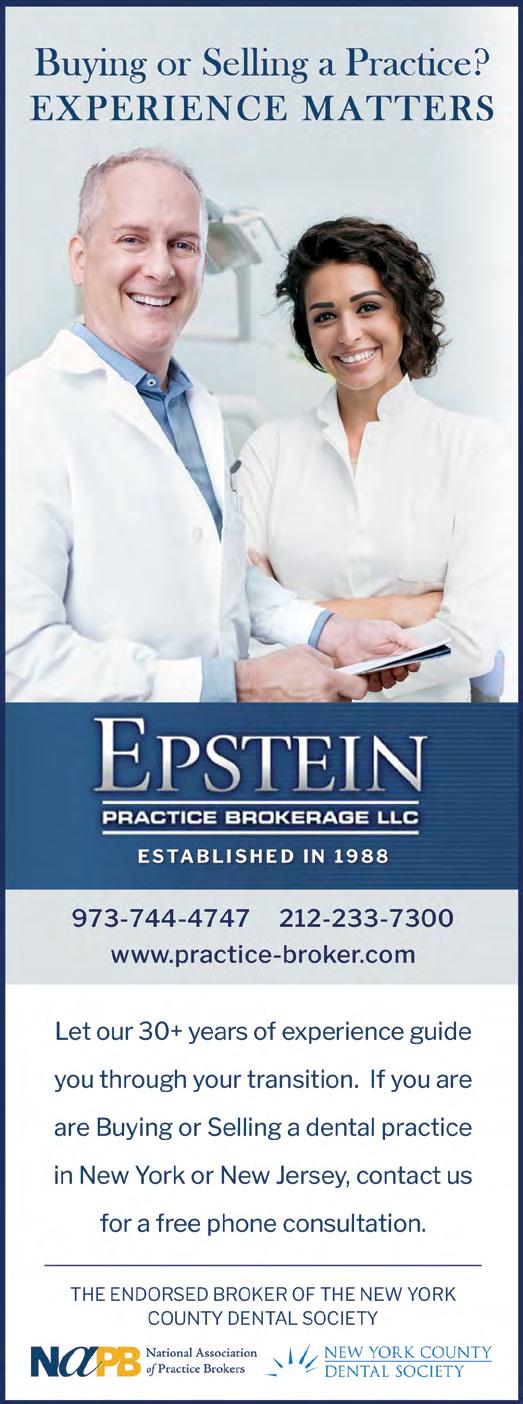
10 minute read
Attorney on Law
New Laws Aim to Improve Oral Health
Increased access to fluoride varnish and expanded health and wellness campaign expected to improve oral health of children and adults.
Lance Plunkett, J.D., LL.M.
The end of 2024 brought two new laws that specifically affect dentistry. The first such law, Chapter 457 of the Laws of 2024, took effect on Nov. 15. It amended Section 6608 of the New York State Education Law to allow registered dental assistants to apply topical fluoride varnish. Topical fluoride varnish had previously been limited to dentists and dental hygienists. It also amended Section 6902(2) of the Education Law to allow licensed practical nurses (LPNs) to apply topical fluoride varnishes.
Previously, physicians or dentists could only issue an order to a registered professional nurse (RN) to do so (nurse practitioners and physician assistants also could apply topical fluoride varnish). The general purpose of the new law is to improve children’s dental health outcomes by allowing additional healthcare providers to apply fluoride varnish to teeth when there is a prescription and under protocols of an authorized provider.
The justifications for the new law were that applying fluoride varnish to the teeth of young children is proven to reduce dental disease, that too few children in New York are receiving treatments, and that fluoride varnish application is a standard of care for pediatric offices and for the New York State Medicaid program. Allowing additional types of health providers to perform this service was seen as bringing New York in line with other states and creating more access points at which children and adolescents enrolled in Medicaid could receive this preventive service.
The Legislature reasoned that dental disease in children has been called a “hidden epidemic”—hidden because it is not always apparent until the pain becomes unendurable or until it creates an inability to eat, sleep or concentrate in school. The Legislature also believed that dental disease is hidden by poverty. Most children won’t experience severe dental disease. Instead, the effects are felt primarily by low-income children because it relates to many of the same social and economic factors that drive other health disparities.
In 2021, more than 14% of children in New York reported one or more oral health problems. In 2020, only one in every three New York children enrolled in Medicaid (32.8%) received a preventive dental visit (national median 41.5%), which includes fluoride varnish application. Persistent oral health disparities remain, with children who are Black and Hispanic/Latino and children experiencing poverty most affected by poor dental health.
Interestingly, the Legislature felt compelled to describe fluoride varnish as a topical solution used to prevent tooth decay that, like fluoridated toothpaste, is applied to the surface of teeth. It helps prevent cavities by making the tooth hard and when cavities are just starting or barely visible. Fluoride varnish is painted onto the front and back, top and bottom of the teeth with a tiny brush, where it hardens as soon as it is touched by saliva in the mouth. It takes less than two minutes to apply and requires no special equipment or extensive training to master the technique. The Legislature seemed determined to demonstrate that it was a “no-brainer” to expand who could perform this simple procedure.
The Legislature also noted that there was high quality evidence that fluoride varnish is effective in preventing tooth decay in children at moderate-to high risk and that studies showed that children who received fluoride varnish every three months had fewer cavities than those who got it less often or not at all. The Legislature added that fluoride varnish should be started early, even in infancy, when the first tooth erupts, because it is most effective when applied before tooth decay develops.
New York Medicaid reimburses for up to four applications per child per year. Dental providers can bill Medicaid from birth up to age 21 and medical providers from birth to age 6. The Legislature noted that while providers currently authorized to apply fluoride varnish in New York included dentists, dental hygienists, physicians, nurse practitioners, registered nurses and physician assistants, allowing additional members of care teams to apply the varnish would increase flexibility in offices and provide more opportunities to incorporate the service into visits, and would bring New York in line with many other states that allow a wider variety of health professionals to perform this task.
Oral Health Top of Mind
The second law, Chapter 535 of the Laws of 2024, will take effect on Jan. 21. It amends Section 207 of the New York State Public Health Law to include a new paragraph(s) of subdivision 1 to require that the New York State Department of Health’s Health Care and Wellness Education and Outreach Program include oral health.
Section 207 allows the Department of Health to conduct education and outreach programs for consumers; patients; educators, including but not limited to elementary and secondary school educators; and healthcare providers. Specifically, the new law calls for a public awareness campaign on the importance of good oral health, including but not limited to, the impact of oral disease, causes of oral disease and its prevention, oral health across the lifespan, the total body connection, the value of early detection, and the availability of oral health services in the community.
The general purpose of the new law is to raise public awareness about the importance of good oral health to good overall health and well-being.
The justification for the new law was that good oral health is essential for vital functions of life, including eating, breathing and speaking. The Legislature reasoned that dental disease can result in poor nutrition, school absences, missed workdays, and increasing public and private expenditures for dental care.
In addition, the Legislature noted that periodontal disease increases the risk of heart disease, diabetes and premature birth, and that dentists are important frontline healthcare providers in that infectious diseases, cancer, immune disorders and nutritional deficiencies are often reflected in the health of a patient’s teeth and gums. Accordingly, the new law provides for a public awareness campaign to underline the importance of dental care and oral hygiene in promoting overall health and well-being.
Going after the Bad Guys
These new laws are interesting in that there is renewed focus on the connection between oral health and overall health. That is a good thing that has often been missing in public health policy discussions. Also interesting is that the justifications for the new laws mention the high cost of dental services. That is less of a good thing that increasingly has made its way into public health policy discussions. Superficially, increasing awareness and access to dental care and reducing the cost of dental care seem wonderfully complementary public health goals. But, absent serious innovation, the solutions are elusive and often tend toward less involvement of dentists.
One glaring example of a defective and unserious “innovation” is the now-defunct SmileDirectClub. Recently, and somewhat belatedly, the New York State Attorney General recovered 4.8 million dollars for consumers who continued to be charged by SmileDirectClub even after it had gone bankrupt and completely closed its operations.
SmileDirectClub, an alleged telehealth company that offered dental services, filed for bankruptcy in September 2023, but continued to charge consumers for services even after it abruptly halted its business operations. The Attorney General had received complaints from New Yorkers who were still being charged for services they could no longer receive. Finally, the Attorney General managed, in December 2024, to recover the improperly charged monies for affected consumers. But the SmileDirectClub model of easy access, low cost and little involvement from patients’ dentists ended up as a boondoggle that government realized too late was not promoting public oral health but was, instead, promoting the bank accounts of SmileDirectClub.
Members may not know that many years ago (starting in late 2014), NYSDA had met on multiple occasions with both the Attorney General and the New York State Education Department’s Office of Professional Discipline (OPD) with well-founded complaints about the operation of SmileDirectClub at its inception. Government twiddled its thumbs for 10 years, producing only the Education Department’s advice below to consumers:
“Many companies are now offering ‘Do it Your Self’ or ‘DIY’ dental treatments, often at a reduced fee. Examples of these treatments/products include but are not limited to, orthodontic treatment, tooth whitening, grills, mouthguards, at-home tooth replacement, including crowns and veneers, etc. Here are some suggested questions you should ask yourself when considering one of these treatments/products.
1. “Is the DIY treatment/product legal under New York State laws and regulations?
2. Are your teeth healthy enough for the DIY treatment you are considering? What are the potential risks of this treatment/product?
3. Will you ever see a licensed New York State dentist during the course of your DIY treatment? If you have a problem during the course of treatment or while using the product, who will assist you in addressing it?
4. Will initial records, such as X-rays, photographs and impressions/scans be taken prior to the start of your DIY treatment or the use of the product? Will you have access to these records if needed?
5. Are there any hidden fees that may come up during or after your DIY treatment?
6. Is the company you will be working with asking you to sign a release relieving it of any liability? If you have a dispute or are injured during the course of your DIY treatment or during the use of the product, what rights do you have?
7. Are you considering a DIY treatment that involves the orthodontic movement of your teeth? If so, you should be aware that moving teeth incorrectly can potentially damage teeth, the supporting tissue and permanently change your facial appearance.
8. What will happen if the company you are working with goes out of business?
“Additionally, as part of your DIY treatment, will you receive any office visits to see the orthodontist or dentist? If so, will these visits result in added costs to you?
“Should you have any questions or concerns regarding a ‘Direct to the Consumer’ product, please contact the New York State Education Department at conduct@nysed.gov or 1(800) 442-8106.”
Calling a Halt to CTA
Finally, yet another major court decision was issued on Dec. 3. The United States District Court for the Eastern District of Texas struck down as unconstitutional, under the Tenth Amendment of the United States Constitution (ruling that Congress lacked the power to enact the law because it improperly intruded on rights exclusively left to the states), the federal Corporate Transparency Act (CTA), issuing a nationwide injunction stopping its enforcement that was scheduled to begin on Jan. 1 (many dentists have already complied with the law in 2024).

The case is Texas Top Cop Shop, Inc. v. Garland. On Dec. 5, the federal government filed an appeal in the case with the United States Court of Appeals for the Fifth District. They are already appealing a much more limited decision from an Alabama federal court that applied only to the parties in Alabama. The final fate of the CTA must now be awaited on appeals likely to go to the United States Supreme Court, depending on what the next administration decides to do on appeal.
The federal court decision has no effect on the New York State version of this law that commences on Jan. 1, 2026, and applies only to limited liability companies (LLCs and PLLCs). That law was covered in detail in the March 2024 New York State Dental Journal.
The material contained in this column is informational only and does not constitute legal advice. For specific questions, dentists should contact their own attorney.

